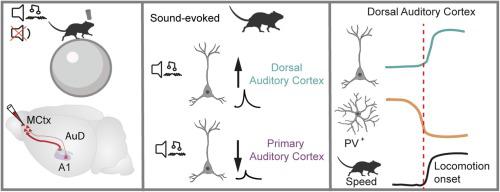Cell Calcium ( IF 4 ) Pub Date : 2021-03-17 , DOI: 10.1016/j.ceca.2021.102390 Julia U Henschke 1 , Alan T Price 2 , Janelle M P Pakan 3

|
As we move through the environment we experience constantly changing sensory input that must be merged with our ongoing motor behaviors - creating dynamic interactions between our sensory and motor systems. Active behaviors such as locomotion generally increase the sensory-evoked neuronal activity in visual and somatosensory cortices, but evidence suggests that locomotion largely suppresses neuronal responses in the auditory cortex. However, whether this effect is ubiquitous across different anatomical regions of the auditory cortex is largely unknown. In mice, auditory association fields such as the dorsal auditory cortex (AuD), have been shown to have different physiological response properties, protein expression patterns, and cortical as well as subcortical connections, in comparison to primary auditory regions (A1) - suggesting there may be important functional differences. Here we examined locomotion-related modulation of neuronal activity in cortical layers ⅔ of AuD and A1 using two-photon Ca2+ imaging in head-fixed behaving mice that are able to freely run on a spherical treadmill. We determined the proportion of neurons in these two auditory regions that show enhanced and suppressed sensory-evoked responses during locomotion and quantified the depth of modulation. We found that A1 shows more suppression and AuD more enhanced responses during locomotion periods. We further revealed differences in the circuitry between these auditory regions and motor cortex, and found that AuD is more highly connected to motor cortical regions. Finally, we compared the cell-type specific locomotion-evoked modulation of responses in AuD and found that, while subpopulations of PV-expressing interneurons showed heterogeneous responses, the population in general was largely suppressed during locomotion, while excitatory population responses were generally enhanced in AuD. Therefore, neurons in primary and dorsal auditory fields have distinct response properties, with dorsal regions exhibiting enhanced activity in response to movement. This functional distinction may be important for auditory processing during navigation and acoustically guided behavior.
中文翻译:

运动过程中小鼠背侧听觉域中细胞类型特异性神经元反应的增强调节
当我们在环境中移动时,我们会经历不断变化的感觉输入,这些输入必须与我们正在进行的运动行为相结合——在我们的感觉和运动系统之间建立动态交互。运动等主动行为通常会增加视觉和躯体感觉皮层中感觉诱发的神经元活动,但有证据表明,运动在很大程度上抑制了听觉皮层中的神经元反应。然而,这种效应是否普遍存在于听觉皮层的不同解剖区域,在很大程度上是未知的。在小鼠中,诸如背侧听觉皮层 (AuD) 等听觉关联区域已被证明具有不同的生理反应特性、蛋白质表达模式以及皮层和皮层下的连接,与初级听觉区域 (A1) 相比 - 表明可能存在重要的功能差异。在这里,我们使用双光子 Ca 检测了皮质层 ⅔ 的 AuD 和 A1 中神经元活动的运动相关调节2+能够在球形跑步机上自由奔跑的头部固定行为小鼠的成像。我们确定了这两个听觉区域中神经元在运动过程中表现出增强和抑制的感觉诱发反应的比例,并量化了调制深度。我们发现 A1 在运动期间表现出更多的抑制和 AuD 更增强的反应。我们进一步揭示了这些听觉区域和运动皮层之间电路的差异,并发现 AuD 与运动皮层区域的联系更加紧密。最后,我们比较了 AuD 中细胞类型特异性运动诱发的反应调节,发现虽然表达 PV 的中间神经元亚群表现出异质反应,但总体而言,该群体在运动过程中受到很大抑制,而兴奋性人群反应在 AuD 中普遍增强。因此,初级和背侧听觉域中的神经元具有不同的反应特性,背侧区域对运动的反应活动增强。这种功能区别对于导航和声学引导行为期间的听觉处理可能很重要。


























 京公网安备 11010802027423号
京公网安备 11010802027423号